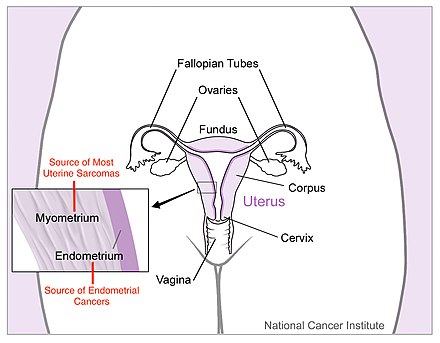Uterine Cancer
Uterine cancer, also known as womb cancer, encompasses two primary types of cancer that develop from the tissues of the uterus: endometrial cancer and uterine sarcoma. Endometrial cancer originates from the lining of the uterus, while uterine sarcoma arises from the muscles or support tissues. Endometrial cancer is the more common type, accounting for approximately 90% of all uterine cancers in the United States.

Types
Endometrial Cancer
Endometrial carcinomas originate from cells in the glands of the endometrium and include:
- Well-differentiated endometrioid adenocarcinoma (common and treatable)
- Uterine papillary serous carcinoma
- Uterine clear-cell carcinoma
Malignant mixed Müllerian tumours, or uterine carcinosarcomas, are rare and exhibit both glandular and stromal differentiation.
Uterine Sarcomas
Uterine sarcomas include:
- Leiomyosarcomas, which originate from the muscular layer of the uterus
- Endometrial stromal sarcomas, originating from the connective tissues of the endometrium
Signs and Symptoms
Both types of uterine cancer may present with abnormal vaginal bleeding and discharge. This could manifest as changes in the duration or amount of menstrual bleeding, new bleeding between menses, or postmenopausal bleeding. Additionally, new or increasing pelvic pressure or pain may indicate tumour growth.
Causes and Risk Factors
The exact causes of uterine cancer are not well understood, but hormone imbalance is considered a significant risk factor. Oestrogen receptors on the cancer cells interact with the hormone, possibly promoting increased cell growth and cancer development.
Risk factors for endometrial cancer include:
- Obesity
- Metabolic syndrome
- Type 2 diabetes
- Use of oestrogen-only pills
- Tamoxifen use
- Late menopause
- Family history
For uterine sarcoma, risk factors include:
- Prior radiation therapy to the pelvis
- Tamoxifen use
- Childhood retinoblastoma
- Hereditary leiomyomatosis and renal cell carcinoma (HLRCC) syndrome
Diagnosis
A pelvic exam is often performed to evaluate for uterine cancer, inspecting internal pelvic organs and assessing the size and position of the uterus and ovaries. A Pap smear may be done to collect cervical cells for microscopic examination. Endometrial biopsy, dilatation and curettage, and ultrasound imaging are also common diagnostic tools.
Screening and Prevention
Screening for uterine cancers is generally not recommended, except for women with hereditary conditions increasing their risk (Lynch, Cowden, HLRCC). Combined oral contraceptive pills and progestin-only pills may offer protective effects against uterine cancers. Weight loss and bariatric surgery can reduce risk in obese patients.
Treatment
Treatment depends on the cancer type and stage. For endometrial cancer, five main treatments are employed: surgery, radiation therapy, chemotherapy, hormone therapy, and targeted therapy. The most common treatment is surgical removal of the uterus (hysterectomy), often accompanied by removal of the ovaries and fallopian tubes (salpingo-oophorectomy). Hormone therapy aims to block cancer cell growth, while targeted therapy involves monoclonal antibodies, mTOR inhibitors, and signal transduction inhibitors.
For uterine sarcoma, treatment options include surgery, radiation therapy, chemotherapy, and hormone therapy.
Prognosis
Prognosis varies across uterine cancer types. Factors influencing prognosis include age at diagnosis, cancer stage, grade, histology, depth of myometrial invasion, and spread to lymph nodes or other regions. Endometrial cancer typically has a favourable five-year survival rate when diagnosed early, while uterine sarcomas generally have a poorer prognosis.
Epidemiology

Uterine cancer affects approximately 3.1% of females over their lifetime. In 2015, 3.8 million women worldwide were affected, resulting in 90,000 deaths. North America and Northern Europe have the highest rates of uterine cancer, while Africa and Eastern Asia have the lowest. About 81% of women with uterine cancer survive for five years, with higher survival rates for localised cancer.
United Kingdom
Uterine cancer is the fourth most common cancer among UK females, with around 8,500 diagnoses in 2011 and 2,000 deaths in 2012.
United States
Uterine cancer is the most common invasive gynecologic cancer in the US, with a steadily increasing number of diagnoses, reaching approximately 61,880 new cases in 2019. Incidence rates vary by race, with the highest diagnosis rates in white females. However, black females have the highest death rates from uterine cancer.
Self-assessment MCQs (single best answer)
Which type of uterine cancer originates from the lining of the uterus?
What percentage of uterine cancers in the United States is accounted for by endometrial cancer?
Which of the following is NOT a sub-type of endometrial carcinoma?
Which of the following is a risk factor specifically for uterine sarcoma?
Which diagnostic tool is commonly used to collect cervical cells for microscopic examination?
What is the most common treatment for endometrial cancer?
Which factor does NOT influence the prognosis of uterine cancer?
What is the five-year survival rate for localised uterine cancer?
Which region has the highest rates of uterine cancer?
In the United States, which racial group has the highest death rates from uterine cancer?
Dentaljuce
Dentaljuce provides Enhanced Continuing Professional Development (CPD) with GDC-approved Certificates for dental professionals worldwide.
Founded in 2009 by the award-winning Masters team from the School of Dentistry at the University of Birmingham, Dentaljuce has established itself as the leading platform for online CPD.
With over 100 high-quality online courses available for a single annual membership fee, Dentaljuce offers comprehensive e-learning designed for busy dental professionals.
The courses cover a complete range of topics, from clinical skills to patient communication, and are suitable for dentists, nurses, hygienists, therapists, students, and practice managers.
Dentaljuce features Dr. Aiden, a dentally trained AI-powered personal tutor available 24/7 to assist with queries and provide guidance through complex topics, enhancing the learning experience.
Check out our range of courses, or sign up now!


